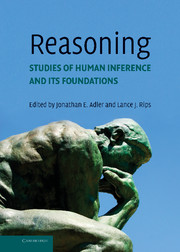Book contents
- Frontmatter
- Contents
- Preface
- List of Contributors
- Introduction: Philosophical Foundations
- PART I FOUNDATIONS OF REASONING
- Section 1 Some Philosophical Viewpoints
- Section 2 Fallacies and Rationality
- 5 When Rationality Fails
- 6 Extensional Versus Intuitive Reasoning: The Conjunction Fallacy in Probability Judgment
- 7 Can Human Irrationality Be Experimentally Demonstrated?
- 8 Breakdown of Will
- PART II MODES OF REASONING
- PART II INTERACTIONS OF REASONING IN HUMAN THOUGHT
- Index
- References
8 - Breakdown of Will
Published online by Cambridge University Press: 05 June 2012
- Frontmatter
- Contents
- Preface
- List of Contributors
- Introduction: Philosophical Foundations
- PART I FOUNDATIONS OF REASONING
- Section 1 Some Philosophical Viewpoints
- Section 2 Fallacies and Rationality
- 5 When Rationality Fails
- 6 Extensional Versus Intuitive Reasoning: The Conjunction Fallacy in Probability Judgment
- 7 Can Human Irrationality Be Experimentally Demonstrated?
- 8 Breakdown of Will
- PART II MODES OF REASONING
- PART II INTERACTIONS OF REASONING IN HUMAN THOUGHT
- Index
- References
Summary
Introduction
There have been plenty of books and articles that describe how irrational we are – in consuming drugs and alcohol and cigarettes, in gambling, in forming destructive relationships, in failing to carry out our own plans, even in boring ourselves and procrastinating. The paradoxes of how people knowingly choose things they'll regret don't need rehashing. Examples of self-defeating behaviors abound. Theories about how this could be are almost as plentiful, with every discipline that studies the problem represented by several. However, the proliferation of theories in psychology, philosophy, economics, and the other behavioral sciences is best understood as a sign that no one has gotten to the heart of the matter.
These theories almost never mention failures of will. This is just not a concept that behavioral scientists used much in the twentieth century. Some writers have even proposed that there's no such thing as a “will,” that the word refers only to someone's disposition to choose. Still, the word crops up a lot in everyday speech, especially as part of “willpower,” something that people still buy books to increase.
It's widely perceived that some factor transforms motivation from a simple reflection of the incentives we face to a process that is somehow ours, that perhaps even becomes us – some factor that lies at the very core of choice-making. We often refer to it as our will, the faculty by which we impose some overriding value of ours on the array of pressures and temptations that seem extrinsic.
- Type
- Chapter
- Information
- ReasoningStudies of Human Inference and its Foundations, pp. 156 - 186Publisher: Cambridge University PressPrint publication year: 2008



